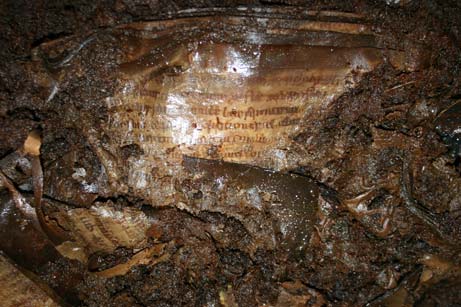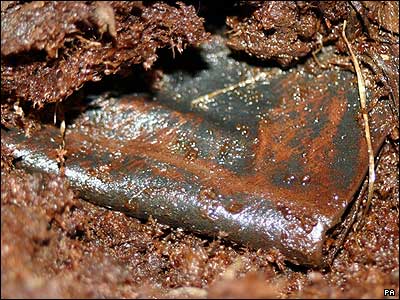| Irish Forums Message Discussion :: RTE Treasure Of The Bogs. Faddan More Psalter |
   | Irish Forums :: The Irish Message
Forums About Ireland and the Irish Community, For the Irish home and Abroad. Forums include- Irish Music, Irish History, The Irish Diaspora, Irish Culture, Irish Sports, Astrology, Mystic, Irish Ancestry, Genealogy, Irish Travel, Irish Reunited and Craic
|  
|
RTE Treasure Of The Bogs. Faddan More Psalter


|
|
|
| Irish
Author |
RTE Treasure Of The Bogs. Faddan More Psalter Sceala Irish Craic Forum Irish Message |
|
Limerick Queen
Sceala Philosopher
|
| Sceala Irish Craic Forum Discussion:
RTE Treasure Of The Bogs. Faddan More Psalter
|
|
|
The story of the Faddan More Psalter is on RTE 1 tonight. Incredible how the psalter buried for so long, that any of it survived at all.

Treasure of the bogs is documentary about a unique archaeological find in County Tipperary which revealed potential links between Irish Christianity and the Coptic Church of the Middle East.
On July 20th 2006, a remarkable archaeological find was uncovered in a remote bog at Faddan More in north Tipperary, close to the town of Birr. Local man Eddie Fogarty was cutting peat with a mechanical digger when he spotted something unusual that looked "like some sort of book".
The find - which has become known as the Faddan More Psalter - was a fragmented illuminated vellum manuscript encased in an unusual leather binding, a book of psalms dating back to the late eighth century. This unprecedented find, the first manuscript to be found in a water-logged state in a bog, posed unique and profound difficulties for the Conservation Department at the National Museum.

This documentary offers exclusive access to the National Museum's team as they embarked upon this dramatic and pain-staking journey of recovery and discovery. It follows leading Irish book conservator John Gillis as he set about preserving and conserving this unique find.
As the process reached its conclusion, fragments of papyrus were dramatically discovered in the lining of the Egyptian-style leather binding. This potentially represents the first tangible connection between early Irish Christianity and the Middle Eastern Coptic Church. It is a finding that asks many questions and has confounded some of the accepted theories about the history of early Christianity in Ireland.
The documentary also travels across Europe and to the deserts of Egypt in an effort to uncover the story behind this perplexing and mysterious discovery.
Faddan More Psalter
The Faddan More Psalter (also Irish Bog Psalter or Faddan Mor Psalter) is an early medieval Christian psalter (prayer book) discovered in a bog in July 2006, in the townland of Faddan More in north County Tipperary, Ireland[1]. It is estimated to have been in the bog for between 1,000 and 1,200 years, but the book itself has yet to be formally identified, named or dated by Irish archaeological authorities. This discovery was hailed by the National Museum of Ireland as one of the most significant Irish archaeological finds in decades. An expert who was called in to advise on the discovery said that he believes the psalter is the first discovery of an Irish early medieval manuscript in two centuries.

Description of the Faddan More Psalter
The book is written in Latin on vellum pages and extensive fragments have survived. Large illuminated initials, typical of Insular art, are visible at the corners. Early research shows that the approximately 20 recovered pages are rectangular sheets, folded in the centre, with a wraparound vellum or leather cover like "a very thick wallet in appearance". It does not have a modern binding. It is believed to have been made by monks in the scriptorium of an Irish Celtic monastery. Low oxygen levels in the bog provide unusual preservation conditions, and bogs were often used by Irish monks as hiding places for valuables in the face of Viking raids. In addition to low oxygen levels, sphagnum moss, of which the peat bog is composed, produces an antibiotic substance called sphagnan that binds with proteins on the surface of microorganisims, immobilizing them. Its highly reactive carbonyl groups can alter chemicals and nutrients that would otherwise decompose organic matter. And above all the sphagnum moss causes organic material to undergo chemical changes itself that make it impervious to rot.
Discovery of the Faddan More Psalter
It was uncovered by bulldozer driver Eddie Fogarty,[1] a worker extracting peat with a backhoe. Dr. Patrick Wallace, director of the National Museum, praised Fogarty for immediately having covered the book with damp soil, as exposure to dry air after so many centuries of dampness might have destroyed it. The book is being stored in refrigeration at the National Museum. Identifying the safest way to pry open the pages without damaging or destroying them could take months, and conservation work could take two years. The area around Faddan More Bog is rich in medieval history. Monastic foundations such as Lorrha and Terryglass in Co. Tipperary and Birr and Seirkieran in Co. Offaly are located nearby.
The bog is owned by local brothers Kevin and Patrick Leonard. Six years before the psalter find, a leather satchel was found that, by radiocarbon dating, was estimated to originate from between the seventh and ninth centuries. This was located just 100m from the psalter findspot and is of a similar date suggesting that the satchel may have originally contained the book. Additionally, in recent years two ancient wooden vessels were also found in the same bog.
Misreported prophecy of the Faddan More Psalter
When found, the book was opened to a page displaying Psalm 83 (in the Septuagint numbering), which corresponds with Psalm 84 in the Masoretic numbering used in most English-language translations. Due to confusion regarding differences in numbering the Psalms, some news sites implied that the Psalter was open at the Masoretic Psalm 83. That psalm contains such lines as "They have said, Come, and let us cut them off from being a nation; that the name of Israel may be no more in remembrance"; this reference to the attempted destruction of Israel connected the find in some people's minds with the contemporaneous 2006 Israel-Lebanon conflict. The matter was clarified by the director of the National Museum of Ireland, who pointed out the difference in Septuagint vs. Masoretic numbering and that the displayed psalm contains no reference to the destruction of Israel.
Conservation of the Faddan More Psalter
The National Museum of Ireland consulted with specialists in archaeological conservation and book conservation about the best way to conserve the psalter, and received partly conflicting advice. Ultimately a multi-phase conservation plan was determined. The first phase involved non-destructive examination of the book in the form in which it was discovered - e.g., photography, MRI scanning, and examination of the binding by book-binding specialists. In the second phase, experiments were done on 18th century parchments to determine the best way of drying waterlogged parchment. The most effective method involved soaking the parchment in ethanol to replace the water, placing it between blotting sheets, and vacuum-packing it. In the third phase, this technique was tested on small fragments of the psalter, and found to be effective. Conservationists then began applying this method to larger sections of the psalter.
|
|
|
|
|
|
|
|
|
|












